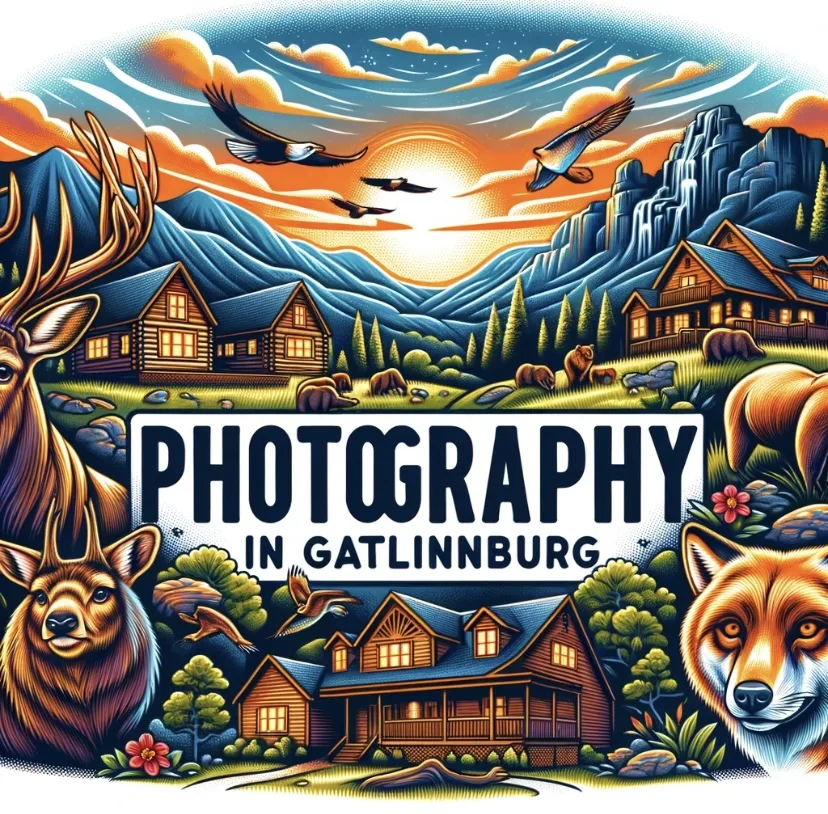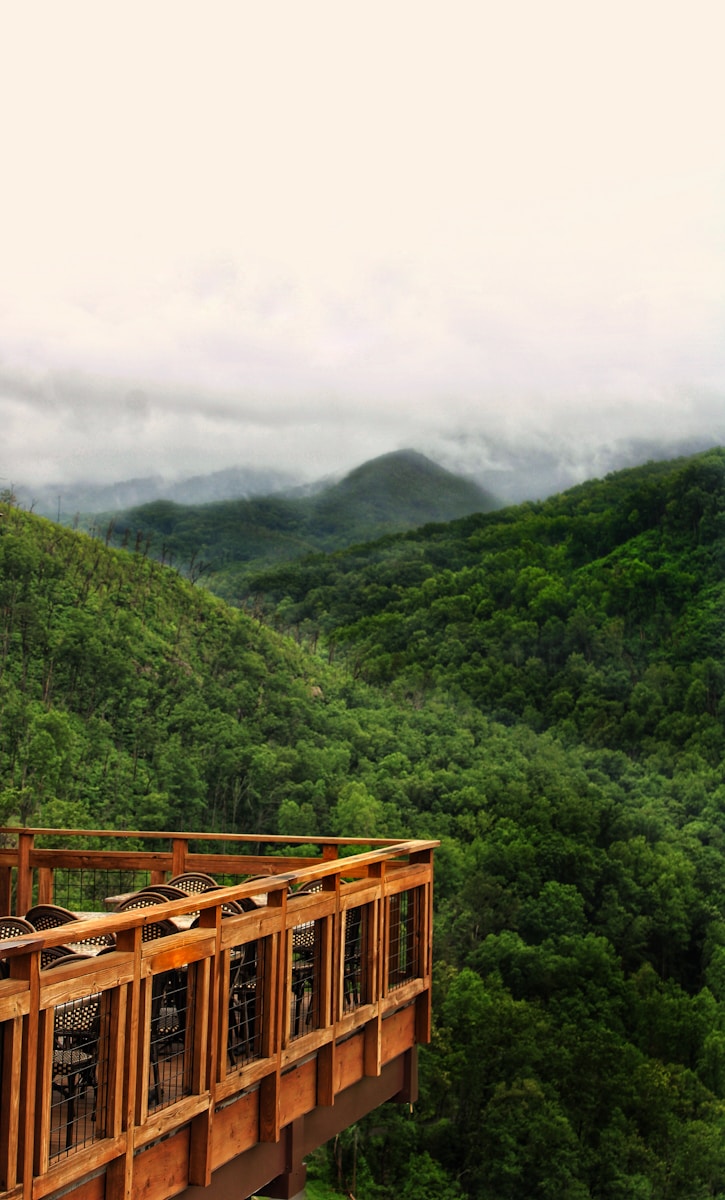If you’re planning a trip to Gatlinburg and want to capture stunning photographs, you’ve come to the right place! In this article, we’ll provide you with a comprehensive guide on the best ways to capture the beauty of Gatlinburg through your lens.

From scenic overlooks and vantage points to capturing the diverse wildlife, seasonal photography, water features, architectural and cultural spots, tips for night sky and astrophotography, mastering photography techniques in nature, and preparing for your photography adventure, we’ll cover it all. Whether you’re a beginner or an experienced photographer, these tips and techniques will help you take your photography to the next level in Gatlinburg. Get ready to create extraordinary images that will leave you with lasting memories of your trip.
Scenic Overlooks and Vantage Points – Great Photographs in Gatlinburg
Clingmans Dome: Gatlinburg’s Highest Point
When it comes to capturing panoramic views of Gatlinburg and its stunning surroundings, Clingmans Dome is a must-visit location. As the highest point in Gatlinburg, it offers a breathtaking 360-degree view of the Great Smoky Mountains National Park. The observation tower located at the summit provides a vantage point that is unrivaled in its beauty.
To make the most of your photography at Clingmans Dome, consider visiting during the golden hours of sunrise or sunset. The soft lighting during these times adds a touch of magic to your images, enhancing the natural beauty of the landscape. It is advisable to arrive early to secure a good spot and to allow yourself enough time to set up your equipment.
Gatlinburg SkyLift Park’s Panoramic Views
For another incredible vantage point, head to the Gatlinburg SkyLift Park. This iconic attraction offers breathtaking views of Gatlinburg and the surrounding mountains. The SkyLift takes you on a scenic ride to the top of Crockett Mountain, where you can capture stunning images of the landscape below.
Once you reach the summit, you’ll find a spacious observation deck that provides uninterrupted views of the Smoky Mountains. This is the perfect spot to capture panoramic shots that showcase the beauty of the area. Take your time to explore different angles and compositions to create unique and memorable photographs.
Sunset and Sunrise Hotspots in the Smokies
To capture the magic of the sunrise or sunset in the Smoky Mountains, there are several hotspots you can explore. One popular location is Newfound Gap, which offers stunning views of the sun rising over the mountains. Another great spot is Morton Overlook, where you can capture the warm hues of the setting sun.
When photographing sunrises or sunsets, it’s important to plan ahead and arrive early to secure a good spot. Be prepared with the right equipment, including a sturdy tripod to ensure sharp images, and experiment with different settings and compositions to capture the beauty of the changing light. Remember to be patient and enjoy the peacefulness of the moment as you capture stunning images of Gatlinburg’s natural beauty.
Capturing Gatlinburg’s Diverse Wildlife
Tips for Photographing Black Bears Safely
The Great Smoky Mountains National Park is home to a diverse range of wildlife, including the majestic black bear. If you’re hoping to capture photographs of these fascinating creatures, it’s important to prioritize safety for both yourself and the bears.
First and foremost, never approach or feed a bear. Instead, invest in a telephoto lens that allows you to capture close-up shots from a safe distance. It’s also helpful to visit in the early morning or late afternoon when bears are more active. Be patient and observant, keeping a respectful distance so as not to disturb their natural behavior.
Birdwatching and Photography in Cades Cove
Cades Cove is a paradise for both birdwatchers and photographers alike. This scenic valley is home to a wide variety of bird species, making it an ideal location to capture stunning images of these feathered creatures in their natural habitat.
To optimize your bird photography experience, equip yourself with a telephoto lens that will allow you to capture the birds up close without disturbing them. Research the local bird species beforehand to understand their habits and preferred habitats. Early morning and late afternoon are ideal times to spot birds in Cades Cove, so plan your visit accordingly.
Macro Photography: Capturing Insects and Smaller Creatures
If you have a fascination with insects and smaller creatures, macro photography is the perfect way to capture their intricate beauty up-close. Gatlinburg’s streams, meadows, and forests provide ample opportunities for capturing these remarkable creatures in their natural habitats.
Invest in a macro lens, which will allow you to capture the finest details and create stunning images. Look for subjects such as butterflies, dragonflies, and beetles in the meadows and along the forest trails. Patience is key in macro photography, as these creatures can be elusive. Take your time and experiment with different compositions and lighting to capture the perfect shot of Gatlinburg’s smaller inhabitants.
Seasonal Photography in Gatlinburg
Capturing Fall Foliage in Its Prime
One of the most iconic and breathtaking sights in Gatlinburg is the vibrant display of fall foliage. The changing colors of the leaves create a stunning backdrop for photography enthusiasts.
To capture the essence of fall in Gatlinburg, visit during the peak foliage season, which typically occurs in late October. Explore the various hiking trails in the Great Smoky Mountains National Park, such as the Gatlinburg Trail or the Roaring Fork Motor Nature Trail. These trails offer countless opportunities to photograph the vibrant reds, oranges, and yellows of the changing leaves against the backdrop of the mountains.
Winter Wonderland: Snow-Capped Peaks and Icy Streams
In winter, Gatlinburg transforms into a magical wonderland with snow-capped peaks and frozen streams. This creates a unique and awe-inspiring canvas for photography.
When photographing winter scenes, it’s essential to protect yourself and your equipment from the cold weather. Dress in layers and ensure your camera gear is adequately insulated. Look for reflections in icy streams or capture the stunning contrast between the white snow and the dark tree trunks. Don’t forget to venture out during sunrise or sunset to capture the soft pink and purple hues that often accompany winter skies.
Spring Blooms and Summer Greens in the Mountains
As the seasons transition from winter to spring and summer, Gatlinburg’s landscape comes alive with colorful blooms and lush greenery. This is the ideal time to capture the freshness and vibrancy of the region.
Explore the many trails in the area, such as the Laurel Falls Trail or the Porters Creek Trail, to photograph the blooming wildflowers and budding trees. For stunning landscape shots, consider including elements such as winding rivers or the majestic Smoky Mountains as your backdrop. Take advantage of the longer daylight hours during the summer months to experiment with different lighting conditions and capture the beauty of Gatlinburg in full bloom.
Water Features: Rivers, Streams, and Waterfalls
Techniques for Silky Waterfall Shots
Gatlinburg and its surrounding areas are home to numerous breathtaking waterfalls, providing endless opportunities for stunning photography. To capture the mesmerizing beauty of these cascading waterfalls, try using a technique known as long exposure.
To achieve the silky smooth effect of the water, you’ll need a sturdy tripod to keep your camera steady during the long exposure. Use a smaller aperture (higher f-stop number) to maintain sharpness throughout the image and choose a lower ISO to reduce noise. Experiment with different exposure times to find the perfect balance between capturing the movement of the water and maintaining sharpness in the surrounding elements.
Reflective Photography on Calm Lakes
The calm lakes in and around Gatlinburg offer a tranquil backdrop for mesmerizing reflective photography. Early morning and late evening are ideal times to capture mirror-like images, as the water is usually calmest during these periods.
To achieve stunning reflections, position yourself at the edge of the lake and carefully compose your shot. Look for interesting elements such as mountains or trees that will be reflected in the water. Ensure your camera is level and use a tripod for stability. Experiment with different angles and compositions to create captivating images that showcase the beauty of Gatlinburg’s lakes.
Rapid Movements: Capturing Whitewater Streams
The fast-flowing streams in Gatlinburg’s wilderness present an exciting opportunity for capturing the dynamic power and beauty of moving water. To capture the rapid movements, consider using a faster shutter speed to freeze the water in action.
A tripod is essential to keep the rest of the image sharp while freezing the movement of the water. Experiment with different shutter speeds to determine the desired effect. A faster shutter speed will freeze the droplets in mid-air, while a slower shutter speed will create a sense of motion and flow. Play around with different compositions and angles to capture the energy and power of Gatlinburg’s whitewater streams.
Gatlinburg’s Architectural and Cultural Spots
Historic Buildings and Their Stories
Gatlinburg is rich in history, and its historic buildings provide fascinating subjects for architectural photography. Explore the Great Smoky Arts and Crafts Community, where you’ll find a collection of historic structures that date back to the early 1900s.
Take the time to research the history behind each building, as this will add depth to your photographs. Experiment with different angles and perspectives to capture the intricate details and unique character of these historic buildings. Don’t be afraid to capture them both in daylight and during the golden hours to showcase the different moods and lighting conditions.
Night Photography: Downtown Gatlinburg Lights
When the sun sets, Gatlinburg comes alive with a vibrant display of lights and colors. This is the perfect time to explore the art of night photography and capture the city’s bustling energy.
To capture stunning night shots of downtown Gatlinburg, use a tripod to keep your camera steady during longer exposures. Experiment with different shutter speeds and apertures to capture the desired amount of light and create the perfect balance between the illuminated cityscape and the night sky. Don’t forget to include elements such as streetlights, car trails, or reflections to add depth and interest to your images.
Local Events and Festivals: Capturing the Spirit of Gatlinburg
Gatlinburg hosts a variety of events and festivals throughout the year, providing unique opportunities to capture the spirit and culture of the city. From the Gatlinburg Craftsmen’s Fair to the Smoky Mountain Christmas festival, there is always something happening in Gatlinburg.
Immerse yourself in the festivities and document the excitement and joy of the event. Capture the vibrant colors, unique performances, and candid moments that showcase the spirit of Gatlinburg. Don’t forget to interact with the locals and immerse yourself in the culture to capture truly authentic images that tell a story.
Tips for Night Sky and Astrophotography
Best Spots for Stargazing and Milky Way Shots
The night sky in Gatlinburg offers a canvas filled with stars, making it a haven for astrophotographers. To capture stunning shots of the night sky and the Milky Way, head to areas with minimal light pollution.
Great spots for stargazing and Milky Way photography include Clingmans Dome, Cades Cove, and the Foothills Parkway. Plan your visit during a new moon or a moonless night for optimal conditions. Use a wide-angle lens to capture a larger portion of the sky and set a high ISO to capture the faint details of the stars. Experiment with different compositions and long exposure times to capture the ethereal beauty of the night sky.
Meteor Showers and Celestial Events Calendar
Throughout the year, Gatlinburg is fortunate to witness various celestial events, including meteor showers. To capture these magnificent displays, it’s essential to plan ahead and be aware of the dates and times of these events.
Stay updated with the celestial events calendar and mark your calendar for events such as the Perseid meteor shower in August or the Geminid meteor shower in December. Research the best locations for capturing meteor showers and choose a spot with minimal light pollution. Use a wide-angle lens, a tripod, and a remote shutter release to capture long exposures and increase your chances of capturing stunning meteor shots.
Gear Recommendations for Night Photography
Night photography and astrophotography require specific equipment to capture the best results. Here are some essential gear recommendations:
- Sturdy tripod: A solid tripod is a must-have for long exposure shots and ensuring sharp images in low-light conditions.
- Wide-angle lens: A wide-angle lens allows you to capture a larger portion of the night sky and include more details in your composition.
- Remote shutter release: A remote shutter release minimizes camera shake and allows you to keep your camera steady during long exposures.
- Light pollution filter: A light pollution filter helps reduce unwanted artificial light and enhances the visibility of stars and celestial objects.
- Extra batteries and memory cards: Night photography can quickly drain your camera’s battery, so always carry extra batteries and memory cards to ensure you’re prepared for extended shooting sessions.
Investing in quality gear will greatly enhance your night photography experience in Gatlinburg and increase your chances of capturing stunning images of the night sky.
Mastering Photography Techniques in Nature
Playing with Light: Golden Hour and Blue Hour
One of the keys to capturing stunning photographs in nature is understanding and utilizing different lighting conditions. The golden hour, which occurs during the first hour after sunrise and the last hour before sunset, provides a soft, warm light that adds a touch of magic to your images.
During the golden hour, the low angle of the sun creates long shadows, beautiful colors, and a soft glow that enhances the natural beauty of the landscape. Experiment with different angles and compositions to capture the unique lighting during this time.
Similarly, the blue hour, which occurs before sunrise and after sunset, offers a different mood and color palette. The soft blue lighting during this time creates a serene atmosphere and can make your photographs stand out. Experiment with longer exposures and incorporate elements such as city lights or reflections for captivating blue hour shots.
Depth of Field in Landscape Photography
When photographing landscapes in Gatlinburg, it’s important to consider the depth of field to capture both the foreground and the background in sharp focus.
To achieve a deep depth of field, use a smaller aperture (higher f-stop number) and focus approximately one-third into the scene. This will ensure that objects both near and far are in focus and that you capture the full depth and detail of the landscape. Utilize a sturdy tripod to keep your camera steady during longer exposures when using smaller apertures.
Conversely, if you want to create a shallow depth of field and focus on a specific subject, such as a flower or a tree, use a wider aperture (lower f-stop number) to create a blurred background. Experiment with different focal lengths and apertures to find the right balance and create captivating landscape images.
Movement and Long Exposure Techniques
To add a sense of motion and dynamic energy to your nature photographs, consider experimenting with long exposure techniques. This is especially effective when capturing elements such as waterfalls or flowing streams in Gatlinburg’s wilderness.
To achieve long exposure shots, use a sturdy tripod to keep your camera steady during longer exposures. Set a slower shutter speed (typically around 1-30 seconds) to capture the movement of the water or other moving elements. Neutral density filters can also be used to reduce the amount of light entering the camera, allowing for even longer exposures during bright conditions.
Experiment with different exposure times to determine the desired effect. Longer exposures will create a smoother, more ethereal look, while shorter exposures can still capture motion but with more defined detail. Incorporate other elements, such as rocks or trees, to create a sense of juxtaposition between the stillness and movement, adding interest and depth to your images.
Preparing for Your Photography Adventure
Packing the Right Gear for Gatlinburg’s Terrain
When embarking on a photography adventure in Gatlinburg, it’s crucial to pack the right gear to ensure you can capture the best shots in various terrains and conditions.
Here are some essential items to consider packing:
- Camera body: Choose a camera with manual settings and a high-resolution sensor for maximum flexibility and image quality.
- Lenses: Bring a versatile lens, such as a wide-angle lens, to capture expansive landscapes. Additionally, consider a telephoto lens for wildlife photography and a macro lens for close-up shots.
- Tripod: A sturdy tripod is essential for long exposures, low-light conditions, and stability during more challenging terrains.
- Filters: Consider bringing filters such as polarizing filters to reduce glare and enhance colors, neutral density filters for long exposures, and graduated filters to balance exposure in high-contrast scenes.
- Extra batteries and memory cards: Ensure you have enough power and storage for your photography sessions.
- Lens cleaning kit: Keep your lenses clean and free from dust or smudges with a lens cleaning kit.
- Backpack or camera bag: Invest in a comfortable and durable bag to protect your gear and make it easier to carry during your photography adventures.
Weather Considerations and Timing Your Visit
The weather in Gatlinburg can change quickly, so it’s essential to consider the weather conditions and plan your photography outings accordingly.
Check the weather forecast before heading out, as different weather conditions can create unique opportunities for photography. Cloudy skies can add drama and texture to your images, while rain can create interesting reflections and add a moody atmosphere. Clear skies are perfect for astrophotography and capturing the stars.
Furthermore, take advantage of the different seasons to capture the changing landscapes and natural beauty of Gatlinburg. Consider visiting during the fall for vibrant foliage, winter for snow-covered scenes, or spring for blooming flowers and greenery.
Always prioritize safety and be prepared for unexpected weather changes. Dress appropriately and pack layers to ensure you’re comfortable in varying temperatures. It’s also a good idea to have a waterproof cover for your camera gear to protect it from rain or snow.
Respecting Nature and Leave No Trace Principles
As photographers, it’s crucial to respect and protect the natural environment when capturing images in Gatlinburg. Familiarize yourself with the principles of Leave No Trace, which aim to minimize your impact on the environment and preserve its beauty for future generations.
Some key principles to follow include:
- Stay on designated trails: Stick to established trails and paths to minimize damage to the surrounding flora and fauna.
- Respect wildlife: Observe animals from a safe distance and avoid disturbing their natural behavior. Do not feed or approach wildlife.
- Pack out what you pack in: Carry a trash bag and dispose of any litter properly. Leave the environment as you found it.
- Minimize light pollution: When photographing at night, be mindful of the impact of artificial lighting on the environment and try to minimize light pollution.
By practicing these principles, you can ensure that Gatlinburg’s natural beauty remains preserved and can be enjoyed by future generations of visitors and photographers alike.
In conclusion, Gatlinburg offers a diverse range of photography opportunities, from scenic overlooks and vantage points to capturing wildlife, landscape, water features, architectural spots, and astrophotography. By exploring the various locations, seasons, and techniques discussed in this article, you can capture stunning photographs that showcase the natural beauty and unique charm of Gatlinburg. Remember to pack the right gear, plan your outings according to the weather and timing, and always prioritize the preservation of the environment. So grab your camera and immerse yourself in the incredible world of photography that Gatlinburg has to offer!




Leave a Reply